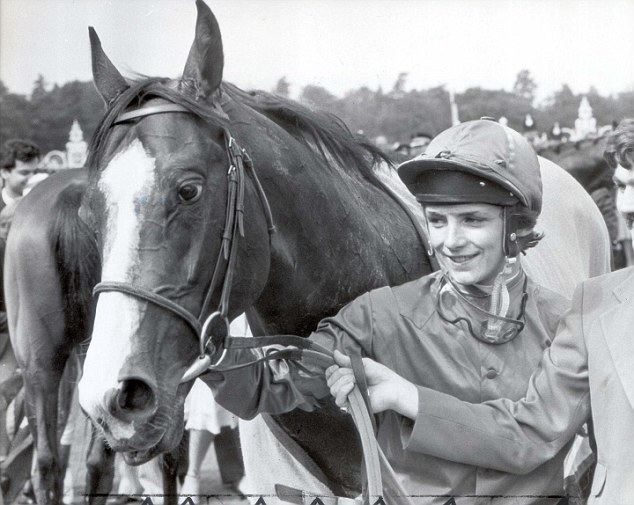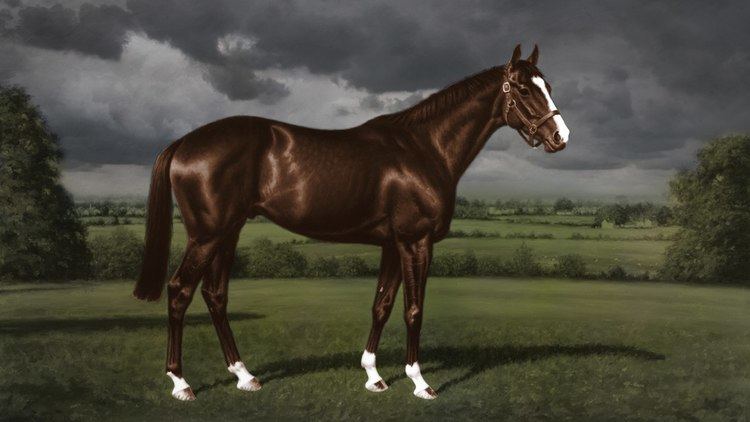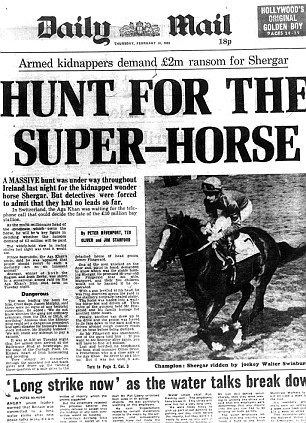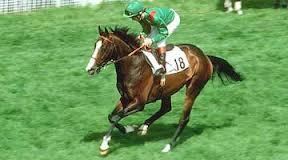Grandsire Honeyway Country Ireland Children Authaal Parents Great Nephew | Foaled 3 March 1978 | |
 | ||
Awards European Horse of the Year | ||
Shergar wins the 1981 derby rare commentary by peter bromley for bbc radio 2
Shergar (3 March 1978 – c. February 1983) was an Irish-bred, British-trained racehorse, and winner of the 202nd Epsom Derby (1981) by ten lengths – the longest winning margin in the race's history.
Contents
- Shergar wins the 1981 derby rare commentary by peter bromley for bbc radio 2
- Who kidnapped shergar
- Background
- 1980 two year old season
- 1981 three year old season
- Stud career
- Theft
- Investigation
- Thieves
- IRA theory
- Whereabouts
- Legacy
- References

Two years later, on 8 February 1983, he was stolen from the Ballymany Stud, near The Curragh in County Kildare, Ireland by masked gunmen and was never seen again. The incident has been the inspiration for several books, documentaries, and a film.

Who kidnapped shergar
Background

Shergar was a bay horse with a broad white blaze bred by his owner the Aga Khan in County Kildare. Ireland. He was sired by Great Nephew, a British stallion whose wins included the Prix du Moulin and whose other progeny included Grundy, Mrs Penny and Tolmi.
Shergar was sent into training with Michael Stoute at Newmarket.
1980: two-year-old season

His first run was a win in a field of 23 by just over two lengths in the Kris Plate, and he set a course record at Newbury. In his only other run – the William Hill Futurity Stakes (now the Racing Post Trophy) at Doncaster, won by Beldale Flutter – he was second, losing by the same two-and-a-half-length margin by which he had won his first race.
1981: three-year-old season

His 3-year-old debut race in 1981 was the Guardian Classic Trial at Sandown Park. Racing correspondent Richard Baerlein, after watching the colt win by 10 lengths, famously advised race-goers that "at 8-1, Shergar for the Derby, now is the time to bet like men."
After winning the Chester Vase by 12 lengths, Shergar started odds-on favourite at Epsom, ridden by 19-year-old jockey Walter Swinburn, also entering his first Derby. Swinburn recalled that early in the race, Shergar "found his own pace and lobbed along as the leaders went off at a million miles an hour, with me just putting my hands down on his withers and letting him travel at his own speed". Shergar pulled to the front early and went further clear, so far that John Matthias on runner-up Glint Of Gold thought he had won: "I told myself I'd achieved my life's ambition. Only then did I discover there was another horse on the horizon."
Shergar's next race was the Irish Derby, ridden by Lester Piggott. The apparent ease with which Shergar passed the rest of the runners, winning by 4 lengths, caused commentator Peter O'Sullevan to exclaim: "He's only in an exercise canter!" The horse became a national hero in Ireland.
Seeking to exploit Shergar's value at its peak, the Aga Khan sold 34 shares in the horse for £250,000 each, keeping six for himself, producing a valuation of £10 million, then a record for a stallion standing at stud in Europe. Among the buyers were bloodstock millionaire John Magnier and Shergar's vet Stan Cosgrove.
Shergar also won the King George VI and Queen Elizabeth Stakes at Ascot by four lengths. After that came his only failure as a three-year-old when the colt apparently failed to stay the extended fourteen furlongs and finished fourth in the St. Leger Stakes at Doncaster. Swinburn was sending out distress signals with two furlongs to go, and Shergar finished behind Cut Above, a horse he had beaten in the Irish Derby. Lester Piggott's view was that "he must have been over the top by then" but, whatever the explanation, Shergar's racing career was over. He had six wins for £436,000 in prize money.
Stud career
In October 1981 Shergar arrived in Newbridge. Greeted by the town band and the cheers of schoolchildren waving flags in the Aga Khan's green and red racing colours, he was paraded up the main street. The Aga Khan, whose decision to stand Shergar in Ireland defied those who had gloomily expected his removal to the United States, was there to greet his prize winner.
Shergar produced 35 foals from his single season at stud, the best turning out to be the 1986 Irish St. Leger winner Authaal, but only one had been born by the time of the theft. The syndicate was able to charge a stud fee of £50,000 - £80,000 for Shergar and if his offspring did well on the track that fee would have doubled. But, despite the thoroughbred’s value, the Ballymany Stud was poorly protected and the criminal gang had little difficulty in gaining access. The theft was the first of its kind in Ireland.
Theft
On 8 February 1983, one week before the start of Shergar's second season at stud - with up to 55 mares - a horse trailer arrived at the stud buildings at 8:30pm. Inside his house, Shergar's groom, James Fitzgerald thought he heard a car in the yard. He listened, heard nothing more, and forgot about it. At 8:40pm, there was a knock at the door. Fitzgerald's son Bernard answered it. The caller was dressed in a Garda (Police) uniform, with a balaclava. He asked for James Fitzgerald, and knocked Bernard to the floor as he turned away. James Fitzgerald came out of the sitting room to see his son on the floor. Three men pushed their way into the house, and held the family at gunpoint in the kitchen. According to Fitzgerald, the thieves were exceptionally calm and well organized and referred to each other as Cresswell.
The intruders signalled for him to put his coat on, and two of them took him outside. Fitzgerald was taken to the stud buildings and led the thieves to Shergar's stall. Fitzgerald was forced to help the thieves load Shergar onto a double horse box which had been drawn up to the stall. Fitzgerald said the gang numbered at least 6 men. Shergar was then towed away, and Fitzgerald was forced into another vehicle and driven around for some 3 hours. Fitzgerald was then thrown out of the car, 7 miles (11 km) from the stud, having been given a password the thieves would use in negotiations.
Investigation
The subsequent police investigation of the kidnapping has been called "a caricature of police bungling". Fitzgerald called the stud farm manager, who called Shergar's vet, Cosgrove. The vet then called a racing associate, Sean Berry, who in turn called Alan Dukes, the Irish Finance Minister and local TD for Newbridge. Dukes in turn gave them the contact number for Michael Noonan, the Minister for Justice. After eight hours had elapsed, someone called the Gardaí.
Their immediate investigation was hampered by a piece of planning by the gang, which had selected the same day as the biggest horse sales in the country, when horseboxes had passed along every road in Ireland. Leading the investigation into the theft was trilby-wearing Chief Superintendent Jim "Spud" Murphy, who was the subject of much media coverage. His detection techniques were unconventional, and a variety of clairvoyants, psychics and diviners were called in to help. During one interview, Mr Murphy told reporters: "A clue... that is what we haven't got."
Despite numerous reported sightings and rumours of secret negotiations in the days following the theft, there was little new information, and the press began to focus their attention on Mr Murphy. During one press conference, six photographers turned up wearing trilbies, identical to the police chief, after which Mr Murphy was given a much lower public profile.
While the police searched farms in the Republic of Ireland, the gang members set about seeking a ransom. Initially, they requested negotiations with three racing journalists, John Oaksey and Derek Thompson, both working for ITV, and Peter Campling, working for The Sun. The day after the theft, Thompson took a call at 1.15am from someone claiming to be one of the thieves. He was dispatched to negotiate in the full glare of the media circus that descended on Ireland. He managed to get the press off his tracks and spent his time in the house of racehorse trainer Jeremy Maxwell taking various calls from the criminals. All he got were demands for a payment of £40,000. On Thursday morning, he received a call telling him that the horse "had an accident" and was "dead".
Away from the TV cameras, the real thieves had got in touch with the Aga Khan's Paris office, not realising that he only had a minority share in the horse's ownership. On discovering that Shergar had multiple owners, the gang agreed to provide evidence that he was still alive. Cosgrove was deputised to collect the evidence, which was to be left at a hotel reception. However, a conspicuous Special Branch presence warned off the gang.
The criminals made a further call threatening to kill Shergar and the Aga Khan's negotiators. Eventually, however, a photograph of the horse's face next to a newspaper was sent to the police, but the owners were still not satisfied. What the gang did not know was that the syndicate had no intention of paying because they wanted to deter future thefts. Syndicate member Sir John Astor explained: "We were going to negotiate, but we were not going to pay." Had they paid the money for Shergar's release, they reasoned, every racehorse in the world would have become a target for theft.
Four days after the abduction, the thieves made their last call. The syndicate issued a statement blaming the Provisional IRA for the crime.
Thieves
The thieves have yet to be brought to justice. Several theories as to their identity and motives have been put forward.
IRA theory
The strongest suspect for the theft is the Provisional Irish Republican Army, whose motive was to raise money for arms. This theory was further supported by Sean O'Callaghan, the IRA supergrass in his book The Informer. He claims that the whole scheme was masterminded by Kevin Mallon and when Shergar panicked, so did the team, resulting in the horse being shot. He also claimed that Shergar was probably shot within hours of being snatched. The thieves, who had no prior experience with the nervous, highly-strung nature of a thoroughbred stallion, were unable to handle him. "One of the gang strongly suggested to me Shergar had been killed within hours. They couldn't cope with him, he went demented in the horsebox, injured his leg and they killed him." Discussing this allegation on the UK’s Channel 4, Fitzgerald said: "I assume he would have got very troublesome. And with them not knowing horses, they would maybe have got a bit scared of him." O'Callaghan said the IRA had demanded a £5 million ransom from the Aga Khan that was never met.
A pit was allegedly dug in the desolate mountains near Ballinamore, County Leitrim. The body was dragged into it and quickly covered over. No markers were left at the grave. The IRA have never officially claimed responsibility for stealing Shergar.
O’Callaghan alleged the gang was part of the IRA's special operations unit, formed with the aim of raising funds through crime. Shergar was to be its first victim, selected because of the wealth of his assumed owner, and the misapprehension that theft of a horse would cause less public outcry than kidnapping a human.
Whereabouts
Shergar's remains have never been found and the thieves have never been officially identified. The Sunday Telegraph reported that four days after Shergar was seized, the Army Council realized they would never collect a ransom. They decided to release the horse, but due to heavy surveillance on Mallon and under the eyes of the entire Irish public, the thieves felt it was impossible to move Shergar or free the horse near where he was held. Mallon thought the horse to be injured, and ordered his execution.
The two thieves, inexperienced in handling racehorses and with no prior knowledge of humane euthanization techniques, went to the remote stable where Shergar was being held and opened fire with a machine gun. A former IRA member involved described the scene to The Sunday Telegraph: "Shergar was machine gunned to death. There was blood everywhere and the horse even slipped on his own blood. There was lots of cussin' and swearin' because the horse wouldn't die. It was a very bloody death."
Few gained from the theft of Shergar - the thieves never got their money and most insurers never paid out to the syndicate, claiming that he could still have been alive after the policy had expired. Insurance policies against theft taken out with forerunners of the Aviva insurance group paid out £144,000, according to Aviva's online archive. According to a spokesman for Lloyd's of London, those members of the syndicate who had been insured for theft were paid $10.6 million in compensation.
Legacy
The Shergar Cup was inaugurated in his honour at Goodwood Racecourse in 1999. The race is now run at Ascot and was a contest between Europe riders and those from the rest of the world. Now the competition is between four teams, Great Britain and Ireland, Europe, The Rest Of The World and for the first time in 2012 an all women team.
The disappearance of Shergar was made into a Hollywood film, Shergar, starring Ian Holm and Mickey Rourke, and directed by Dennis Lewiston.
